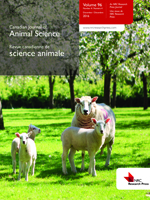Jia-Chun Tian, Ling Han, Qun-Li Yu, Xi-Xiong Shi, Wen-Ting Wang
Canadian Journal of Animal Science 93 (3), 321-328, (1 September 2013) https://doi.org/10.4141/CJAS2012-102
KEYWORDS: Yak meat, Ageing, tenderness, meat quality, tenderization, cathepsins, Viande de yack, maturation, tendreté, qualité de la viande, attendrissement, cathepsines
Tian, J.-C., Han, L., Yu, Q.-L., Shi, X.-X. and Wang, W.-T. 2013. Changes in tenderness and cathepsins activity during post mortem ageing of yak meat. Can. J. Anim. Sci. 93: 321-328. Very little research has been conducted on yak meat tenderization. In this study we investigated the changes in physical characteristics (e.g., pH, water-holding capacity, texture profile analysis, shear force) and cathepsins L, B and H activities in the tenderization process. These traits were quantified in longissimus dorsi muscle from 10 yaks during 192 h post mortem. Samples were aged at 4°C for 0, 12, 24, 36, 48, 72, 120, 168 and 192 h. pH decreased (P<0.05) from 6.84 to 5.54 in the first 72 h and did not change significantly during the next 120 h. Water-holding capacity showed an overall decreasing trend (P<0.05). Shear force decreased? (P<0.05) and myofibrillar fragmentation index increased? (P<0.05), and it was concluded that ageing can improve yak meat tenderness. Our results on texture profile analysis showed a decrease in hardness (P<0.05), springiness (P<0.05) and chewiness (P<0.05), reflected in a progressive softening during ageing (P<0.05). Cathepsins L, B and H activity showed an increased trend (P<0.05). In conclusion, our results show potential roles for cathepsins L, B and H in the tenderization process. This study provides further insights into the tenderization process of yak meat, which may ultimately be used for the advantageous manipulation of the process.

